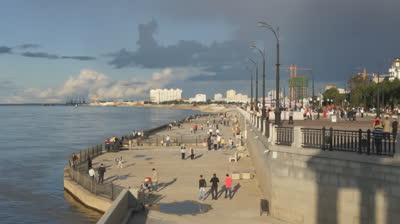The first Russians to appear on these lands were the Cossacks from the detachment of the pioneer Vasily Poyarkov, who came here in 1644. In the middle of the XVII century, the first prison was founded on the left bank of the Amur, but due to the restless relations of the Russians with the Chinese state, this prison was abandoned at the end of the century. The future capital of the Amur Region, as it is believed today, was laid in 1856, when the Ust-Zeysky military post was founded here. The fact is that by this time the need had finally ripened to declare imperial rights to own the left bank of the Amur. Blagoveshchensk began as a frontier fortress laid down during the expansion of state territories - the story is usual for many Russian cities and towns.
Frontier outpost
Throughout the second half of the 19th century, Blagoveshchensk was increasingly strengthened as a bulwark of Russian civilization and statehood in the Far East. In the first years of its existence, the future capital of the Amur Region intensively expanded its territory due to the arrival of new Cossack regiments, which remained with their families for permanent residence. In 1858, the first Orthodox church of the Annunciation of the Blessed Virgin Mary was laid here. By the way, it was by the name of the temple that the village subsequently acquired its own name. In the same year, as a result of the Aigun Treaty between Russia and China, the entire left bank of the Amur River was recognized by the Russian side, and the village received official recognition from the Qing Dynasty. In December 1858, a map of the Amur Region appeared on state maps of the fatherland, and Blagoveshchensk became its administrative center. The creation of the region took place through the highest imperial decree of Alexander II.

Amur Region: the capital
In the second half of the century, the city is increasingly developing. In the sixties, gold deposits were discovered here, which gives a significant impetus to the growth of welfare and status of the city. The river location is increasingly turning Blagoveshchensk into a significant shipping center. Agriculture of the region is developing rapidly. All this, of course, has a positive effect on the development of urban infrastructure and the growth of the local population. The capital of the Amur Region is also gaining importance in the country's heavy industry . So, in 1888, the first iron foundry appeared here, and at the beginning of the 20th century a railway was laid through the city. Of course, in the population of Blagoveshchensk , the Chinese were always present in a considerable proportion. The troubled start of a new century in both Russia and the Celestial Empire brought the city a number of national clashes. So in 1900, the so-called Boxer Uprising led to military clashes between Russians and Chinese in the Far East. As a result of these events, the latter were partially destroyed and for the most part expelled from the city.

Soviet period
During the civil war, the capital of the Amur Region was occupied for some time by Japanese troops, who tried to extract their own profit and appropriate a part of the territories of the former empire. However, they were expelled by local partisans in the summer of 1920. Since 1922, Blagoveshchensk with adjacent territories became part of the Soviet state. In 1920-30 the heavy and light industry again actively developed here. The specifics of the border city left its mark on local trade - the city became one of the main points of smuggling. During the Great Patriotic War, the Far East is one of the important components of the domestic industry working for the needs of the front. And in the post-war period, Blagoveshchensk for a long time remained a city closed to entry, since strategically important enterprises were located here. A new era came only with perestroika in the mid-1980s.